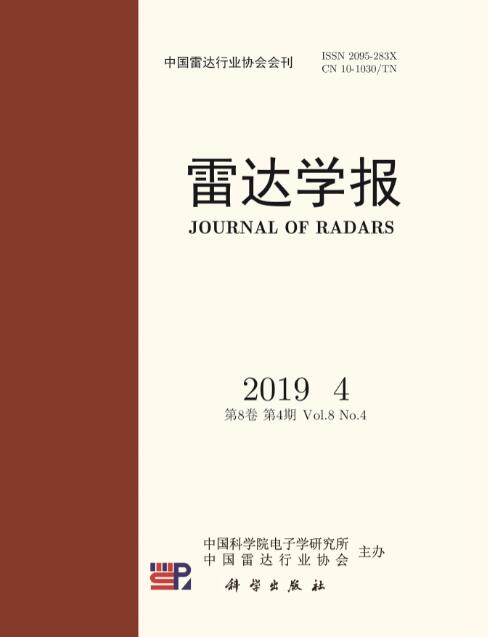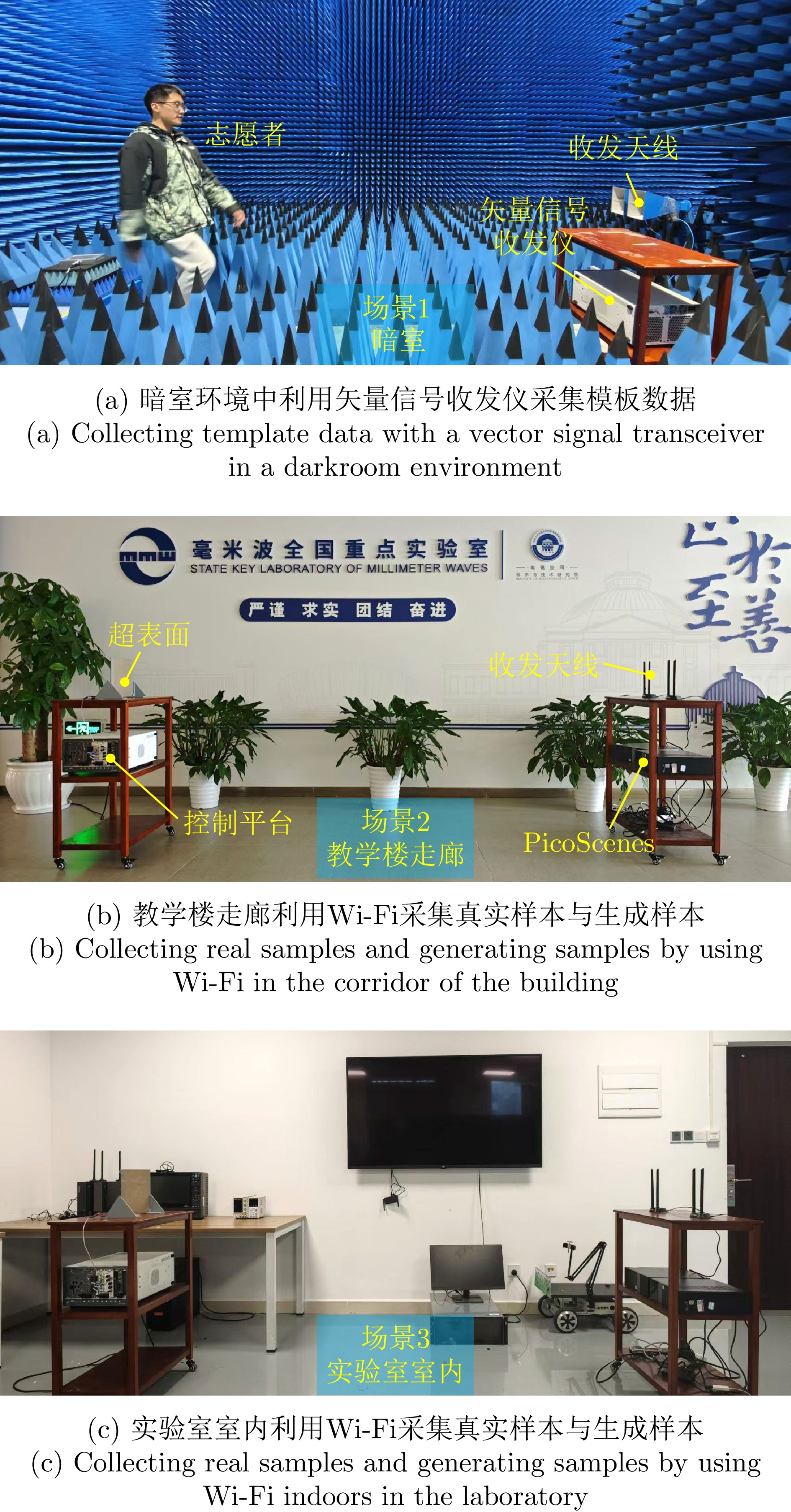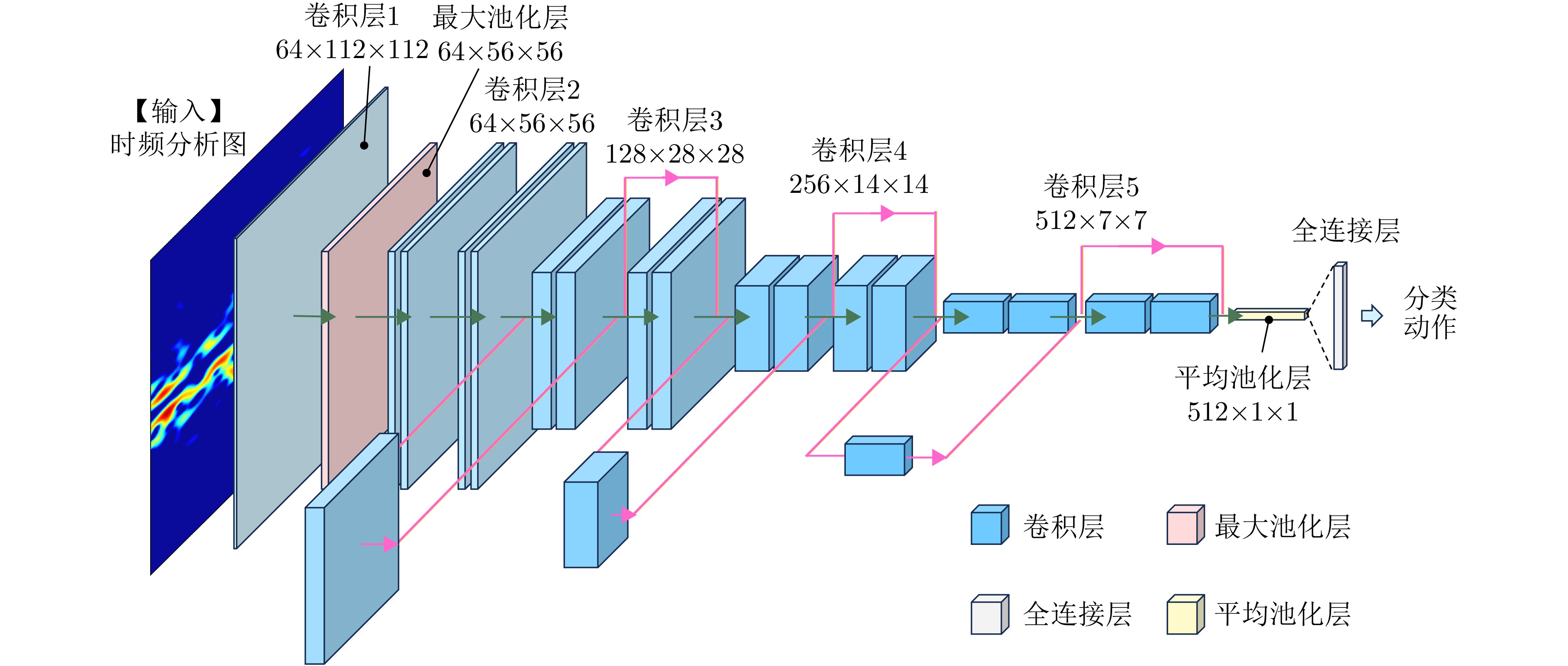- Home
-
Articles & Issues

-
Data

- Dataset of Radar Detecting Sea
- SAR Dataset
- SARGroundObjectsTypes
- SARMV3D
- 3DRIED
- UWB-HA4D
- LLS-LFMCWR
- FAIR-CSAR
- FUSAR
- MSAR
- SDD-SAR
- DatasetinthePaper
- SpaceborneSAR3Dimaging
- DatasetintheCompetition
- Sea-land Segmentation
- SAR-Airport
- Hilly and mountainous farmland time-series SAR and ground quadrat dataset
-
Report

-
Course

-
About

-
Publish

- Editorial Board
- Chinese
Article Navigation >
Journal of Radars
>
2025
> Online First
| Citation: | CHEN Shaonan, GU Jiaming, XU Chao, et al. Fall feature simulation and Wi-Fi sensing dataset construction based on time-domain digital coding metasurface[J]. Journal of Radars, in press. doi: 10.12000/JR24247 |
Fall Feature Simulation and Wi-Fi Sensing Dataset Construction Based on Time-domain Digital Coding Metasurface
DOI: 10.12000/JR24247 CSTR: 32380.14.JR24247
More Information-
Abstract
With the widespread application of Wi-Fi sensing technology in intelligent health monitoring, constructing high-quality perception datasets has become a key challenge. Particularly in monitoring abnormal behaviors, such as falls, traditional methods rely on repeated human experiments, which not only poses safety risks but also raises ethical concerns. To address these issues, this paper proposes a time-domain digital coding metasurface-assisted data acquisition method. By simulating the Doppler effect and micro-Doppler characteristics of the human body, the time-domain digital coding metasurface can effectively replace human experiments and assist in constructing Wi-Fi sensing datasets. To verify the feasibility of this method, we develop a time-domain digital coding metasurface with 0°–360° full-phase modulation capability. Experimental results show that the signals generated by the metasurface retain the motion characteristics of the human body, complement real samples, reduce the complexity of data collection, and finally improve the monitoring accuracy of the classification model significantly. This method provides an innovative and feasible solution for data acquisition for Wi-Fi sensing technology. -
References
[1] REN Yili, WANG Yichao, CHEN Yingying, et al. A vision-based approach for commodity WiFi sensing[C]. The 20th ACM Conference on Embedded Networked Sensor Systems, Boston, USA, 2022: 800–801. doi: 10.1145/3560905.3568068.[2] ZHANG Jie, TANG Zhanyong, LI Meng, et al. CrossSense: Towards cross-site and large-scale WiFi sensing[C]. The 24th Annual International Conference on Mobile Computing and Networking, New Delhi, India, 2018: 305–320. doi: 10.1145/3241539.3241570.[3] MA Yongsen, ZHOU Gang, and WANG Shuangquan. WiFi sensing with channel state information: A survey[J]. ACM Computing Surveys (CSUR), 2020, 52(3): 46. doi: 10.1145/3310194.[4] JIANG Hongbo, CAI Chao, MA Xiaoqiang, et al. Smart home based on WiFi sensing: A survey[J]. IEEE Access, 2018, 6: 13317–13325. doi: 10.1109/ACCESS.2018.2812887.[5] SUN Yimiao, HE Yuan, ZHANG Jiacheng, et al. BIFROST: Reinventing WiFi signals based on dispersion effect for accurate indoor localization[C]. The 21st ACM Conference on Embedded Networked Sensor Systems, Istanbul, Turkiye, 2023: 376–389. doi: 10.1145/3625687.3625786.[6] CHEN Yulong, GUO Junchen, SUN Yimiao, et al. ElaSe: Enabling real-time elastic sensing resource scheduling in 5G vRAN[C]. 2024 IEEE/ACM 32nd International Symposium on Quality of Service (IWQoS), Guangzhou, China, 2024: 1–10. doi: 10.1109/IWQoS61813.2024.10682934.[7] MONJUR M, LIU Jia, XU Jingye, et al. Data distribution dynamics in real-world WiFi-based patient activity monitoring for home healthcare[C]. 2024 IEEE 12th International Conference on Healthcare Informatics (ICHI), Orlando, USA, 2024: 228–233. doi: 10.1109/ICHI61247.2024.00037.[8] CHEN H H, LIN Chilun, and CHANG C H. WiFi-based detection of human subtle motion for health applications[J]. Bioengineering, 2023, 10(2): 228. doi: 10.3390/bioengineering10020228.[9] GU Zhihao, HE Taiwei, WANG Ziqi, et al. Device-free human activity recognition based on dual-channel transformer using WiFi signals[J]. Wireless Communications and Mobile Computing, 2022, 2022(1): 4598460. doi: 10.1155/2022/4598460.[10] WANG Hao, ZHANG Daqing, MA Junyi, et al. Human respiration detection with commodity WiFi devices: Do user location and body orientation matter?[C]. 2016 ACM International Joint Conference on Pervasive and Ubiquitous Computing, Heidelberg, Germany, 2016: 25–36. doi: 10.1145/2971648.2971744.[11] SUN Xian, WANG Peijin, YAN Zhiyuan, et al. FAIR1M: A benchmark dataset for fine-grained object recognition in high-resolution remote sensing imagery[J]. ISPRS Journal of Photogrammetry and Remote Sensing, 2022, 184: 116–130. doi: 10.1016/j.isprsjprs.2021.12.004.[12] ZHANG Wei, TANG Ping, and ZHAO Lijun. Remote sensing image scene classification using CNN-CapsNet[J]. Remote Sensing, 2019, 11(5): 494. doi: 10.3390/rs11050494.[13] IGUAL R, MEDRANO C, and PLAZA I. A comparison of public datasets for acceleration-based fall detection[J]. Medical Engineering & Physics, 2015, 37(9): 870–878. doi: 10.1016/j.medengphy.2015.06.009.[14] KWOLEK B and KEPSKI M. Human fall detection on embedded platform using depth maps and wireless accelerometer[J]. Computer Methods and Programs in Biomedicine, 2014, 117(3): 489–501. doi: 10.1016/j.cmpb.2014.09.005.[15] MA Chao, SHIMADA A, UCHIYAMA H, et al. Fall detection using optical level anonymous image sensing system[J]. Optics & Laser Technology, 2019, 110: 44–61. doi: 10.1016/j.optlastec.2018.07.013.[16] LIU Mengwei, ZHANG Yujia, WANG Jiachuang, et al. A star-nose-like tactile-olfactory bionic sensing array for robust object recognition in non-visual environments[J]. Nature Communications, 2022, 13(1): 79. doi: 10.1038/s41467-021-27672-z.[17] HAO Xuejie, LIU Lu, YANG Rongjin, et al. A review of data augmentation methods of remote sensing image target recognition[J]. Remote Sensing, 2023, 15(3): 827. doi: 10.3390/rs15030827.[18] SHORTEN C and KHOSHGOFTAAR T M. A survey on image data augmentation for deep learning[J]. Journal of Big Data, 2019, 6(1): 60. doi: 10.1186/s40537-019-0197-0.[19] DUONG H T and NGUYEN-THI T A N. A review: Preprocessing techniques and data augmentation for sentiment analysis[J]. Computational Social Networks, 2021, 8(1): 1. doi: 10.1186/s40649-020-00080-x.[20] GAO Xin, DENG Fang, and YUE Xianghu. Data augmentation in fault diagnosis based on the Wasserstein generative adversarial network with gradient penalty[J]. Neurocomputing, 2020, 396: 487–494. doi: 10.1016/j.neucom.2018.10.109.[21] LAN Lan, YOU Lei, ZHANG Zeyang, et al. Generative adversarial networks and its applications in biomedical informatics[J]. Frontiers in Public Health, 2020, 8: 164. doi: 10.3389/fpubh.2020.00164.[22] WANG Siran, CHEN Mingzheng, KE Junchen, et al. Asynchronous space-time-coding digital metasurface[J]. Advanced Science, 2022, 9(24): 2200106. doi: 10.1002/advs.202200106.[23] ZHOU Qunyan, DAI Junyan, FANG Zuqi, et al. Generalized high-precision and wide-angle DOA estimation method based on space-time-coding digital metasurfaces[J]. IEEE Internet of Things Journal, 2024, 11(23): 38196–38206. doi: 10.1109/JIOT.2024.3445451.[24] ZHOU Qunyan, WU Junwei, WANG Siran, et al. Two-dimensional direction-of-arrival estimation based on time-domain-coding digital metasurface[J]. Applied Physics Letters, 2022, 121(18): 181702. doi: 10.1063/5.0124291.[25] CUI Tiejun, QI Meiqing, WAN Xiang, et al. Coding metamaterials, digital metamaterials and programmable metamaterials[J]. Light: Science & Applications, 2014, 3(10): e218. doi: 10.1038/lsa.2014.99.[26] LI Lianlin, CUI Tiejun, JI Wei, et al. Electromagnetic reprogrammable coding-metasurface holograms[J]. Nature Communications, 2017, 8(1): 197. doi: 10.1038/s41467-017-00164-9.[27] ZHAO Jie, YANG Xi, DAI Junyan, et al. Programmable time-domain digital-coding metasurface for non-linear harmonic manipulation and new wireless communication systems[J]. National Science Review, 2019, 6(2): 231–238. doi: 10.1093/nsr/nwy135.[28] DAI Junyan, YANG Liuxi, KE Junchen, et al. High-efficiency synthesizer for spatial waves based on space-time-coding digital metasurface[J]. Laser & Photonics Reviews, 2020, 14(6): 1900133. doi: 10.1002/lpor.201900133.[29] LI Shiyuan, WANG Jianyang, FANG Xinyu, et al. Jamming of ISAR imaging with time-modulated metasurface partially covered on targets[J]. IEEE Antennas and Wireless Propagation Letters, 2023, 22(2): 372–376. doi: 10.1109/LAWP.2022.3212923.[30] KE Junchen, CHEN Xiangyu, TANG Wankai, et al. Space-frequency-polarization-division multiplexed wireless communication system using anisotropic space-time-coding digital metasurface[J]. National Science Review, 2022, 9(11): nwac225. doi: 10.21203/rs.3.rs-1509959/v1.[31] WANG Siran, DAI Junyan, ZHOU Qunyan, et al. Manipulations of multi-frequency waves and signals via multi-partition asynchronous space-time-coding digital metasurface[J]. Nature Communications, 2023, 14(1): 5377. doi: 10.1038/s41467-023-41031-0.[32] KE Junchen, DAI Junyan, ZHANG Junwei, et al. Frequency-modulated continuous waves controlled by space-time-coding metasurface with nonlinearly periodic phases[J]. Light: Science & Applications, 2022, 11(1): 273. doi: 10.1038/s41377-022-00973-8.[33] WANG Siran, DAI Junyan, KE Junchen, et al. Radar micro-Doppler signature generation based on time-domain digital coding metasurface[J]. Advanced Science, 2024, 11(19): 2306850. doi: 10.1002/advs.202306850.[34] HE Yuan, ZHANG Jia, XI Rui, et al. Detection and identification of non-cooperative UAV using a COTS mmWave radar[J]. ACM Transactions on Sensor Networks, 2024, 20(2): 44. doi: 10.1145/3638767.[35] CHEN Yande, HE Yuan, SUN Yimiao, et al. mmTAI: Biometrics-assisted multi-person tracking with mmWave radar[C]. 2024 IEEE 30th International Conference on Parallel and Distributed Systems (ICPADS), Belgrade, Serbia, 2024: 26–33. doi: 10.1109/ICPADS63350.2024.00014.[36] ZHANG Jia, XI Rui, HE Yuan, et al. A survey of mmWave-based human sensing: Technology, platforms and applications[J]. IEEE Communications Surveys & Tutorials, 2023, 25(4): 2052–2087. doi: 10.1109/COMST.2023.3298300.[37] JAGANATHAN D, BALSUBRAMANIAM S, SURESHKUMAR V, et al. Concatenated modified LeNet approach for classifying pneumonia images[J]. Journal of Personalized Medicine, 2024, 14(3): 328. doi: 10.3390/jpm14030328.[38] TANG Chong, VISHWAKARMA S, LI Wenda, et al. Augmenting experimental data with simulations to improve activity classification in healthcare monitoring[C]. 2021 IEEE Radar Conference, Atlanta, USA, 2021: 1–6. doi: 10.1109/RadarConf2147009.2021.9455314. -
Proportional views

- Figure 1. Schematic diagram of human fall behavior feature simulation based on time-domain digital coding metasurface
- Figure 2. Structure and electromagnetic characteristics of time-domain digital coding metasurface
- Figure 3. Scene construction of three experimental groups
- Figure 4. LeNet network architecture
- Figure 5. Time-frequency analysis results of five types of actions (corresponding to falling down, running closer, running away, approaching and walking away respectively)
- Figure 6. Quality detection of motion feature signals generated by time-encoding metasurface


 Submit Manuscript
Submit Manuscript Peer Review
Peer Review Editor Work
Editor Work






 DownLoad:
DownLoad:




